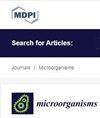分析微生物组合成数据的新型斜坡矩阵图算法
IF 4.1
2区 生物学
Q2 MICROBIOLOGY
引用次数: 0
摘要
根据高通量测序数据,网络被广泛用于表示物体之间的关系,包括生态系统中的微生物。然而,适当的统计算法、稀有类群的处理、组成数据中过多的零以及解释等方面都存在挑战。这项研究引入了一种新颖的斜率矩阵图(SMG)算法,主要根据基于斜率的距离计算来识别微生物组的相关性。SMG 可有效处理组成数据中的任何零比例,包括:(1)根据环境中的 "感兴趣目标 "搜索相关关系(如正向和负向变化),以及(2)通过对象间基于斜率的距离量化图变化。对模拟数据集的评估表明,SMG 能够准确地将微生物聚类为不同的正/负相关组,在灵敏度和特异性方面都优于 Bray-Curtis 和 SparCC 等方法。此外,与 ZicoSeq 和 ANCOM-BC2 相比,SMG 在检测丰度差异(DA)方面表现出更高的准确性,使其成为微生物组分析的强大工具。SMG 的一个关键优势是其无需转换即可分析零膨胀成分数据的天然能力。总之,这种简单而强大的算法有望用于各种微生物组分析应用。本文章由计算机程序翻译,如有差异,请以英文原文为准。
A Novel Slope-Matrix-Graph Algorithm to Analyze Compositional Microbiome Data
Networks are widely used to represent relationships between objects, including microorganisms within ecosystems, based on high-throughput sequencing data. However, challenges arise with appropriate statistical algorithms, handling of rare taxa, excess zeros in compositional data, and interpretation. This work introduces a novel Slope-Matrix-Graph (SMG) algorithm to identify microbiome correlations primarily based on slope-based distance calculations. SMG effectively handles any proportion of zeros in compositional data and involves: (1) searching for correlated relationships (e.g., positive and negative directions of changes) based on a “target of interest” within a setting, and (2) quantifying graph changes via slope-based distances between objects. Evaluations on simulated datasets demonstrated SMG’s ability to accurately cluster microbes into distinct positive/negative correlation groups, outperforming methods like Bray–Curtis and SparCC in both sensitivity and specificity. Moreover, SMG demonstrated superior accuracy in detecting differential abundance (DA) compared to ZicoSeq and ANCOM-BC2, making it a robust tool for microbiome analysis. A key advantage is SMG’s natural capacity to analyze zero-inflated compositional data without transformations. Overall, this simple yet powerful algorithm holds promise for diverse microbiome analysis applications.
求助全文
通过发布文献求助,成功后即可免费获取论文全文。
去求助
来源期刊

Microorganisms
Medicine-Microbiology (medical)
CiteScore
7.40
自引率
6.70%
发文量
2168
审稿时长
20.03 days
期刊介绍:
Microorganisms (ISSN 2076-2607) is an international, peer-reviewed open access journal which provides an advanced forum for studies related to prokaryotic and eukaryotic microorganisms, viruses and prions. It publishes reviews, research papers and communications. Our aim is to encourage scientists to publish their experimental and theoretical results in as much detail as possible. There is no restriction on the length of the papers. The full experimental details must be provided so that the results can be reproduced. Electronic files and software regarding the full details of the calculation or experimental procedure, if unable to be published in a normal way, can be deposited as supplementary electronic material.
 求助内容:
求助内容: 应助结果提醒方式:
应助结果提醒方式:


